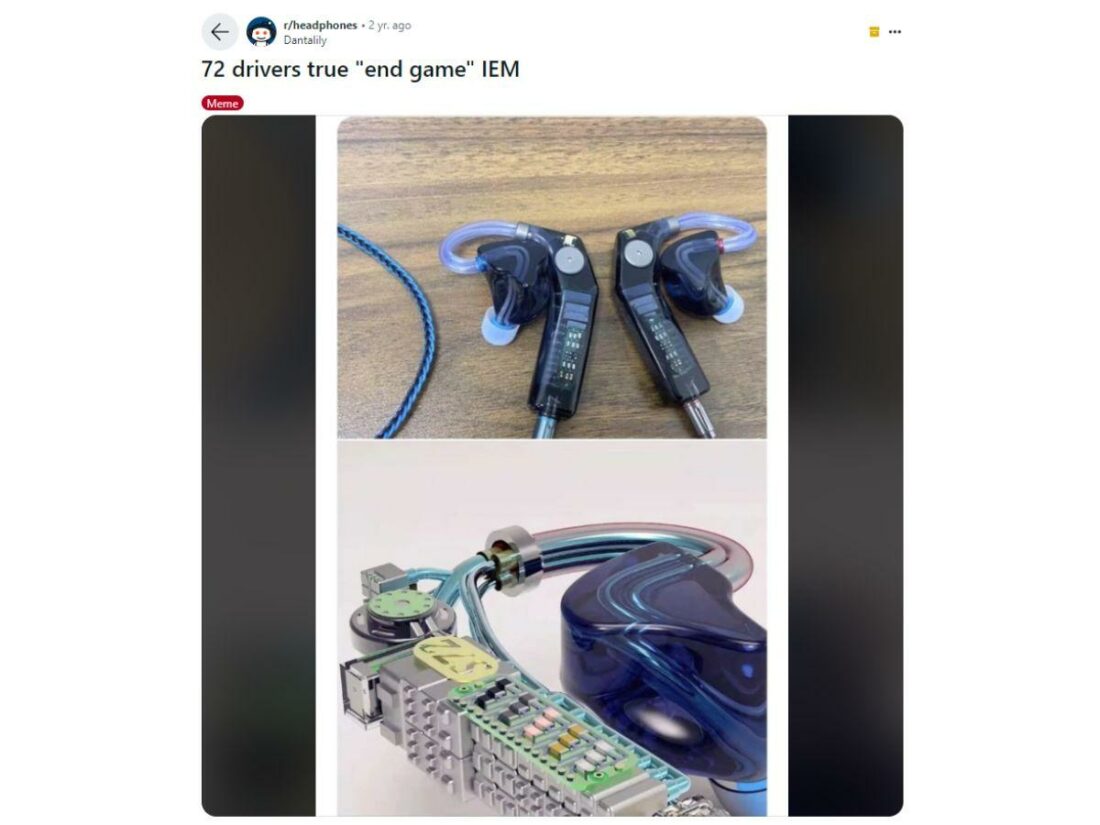Does a higher driver count equate to higher quality?
A Reddit netizen has once more unearthed pictures of long-gone 72-driver wonder IEMs, the S72. This got others intrigued about the merits of going all out with the driver count, while others doubted it’s just all about specmanship and not performance.
The 72-Driver Earbuds
As it’s often with these posts, this isn’t the first time the earbuds were revealed. The original was posted 2 years ago, with a more informative discussion. Apparently, the earbuds were called the “S72”, with an unknown manufacturer.

By far, the most insightful comments that time came from the IEM enthusiast extraordinaire Oratory1990, who also happens to be an acoustician.
Despite the whole concept being mildly ridiculous, the main point of criticism was the decision to use the extremely long sound tube, which introduced a plethora of acoustic issues.

After doing some extra research about the IEMs in question, we found out that the S72 were only produced for a short while in 2021. These were offered on Taobao for roughly US$1700.
But, to this day, no owner has gone public with their impressions of the enigmatic IEMs.

Enter the Driver War
These IEMs could be a direct result of what we call “the driver war”.
We got a first glimpse of the driver count war around 14 years ago. At this time, the first custom IEMs came out. And, the 3D-printed medical acrylic shells had enough space to cram many balanced armature modules inside.
Universal fit IEMs usually stuck to no more than 5 balanced-armature drivers because the ear shells weren’t large enough to house more. Only when 3D-printing medical acrylic became more available did the shells allow for truly crazy driver counts.

Nowadays, manufacturers put everything but the kitchen sink in IEMs in an attempt to achieve a unique tuning and, let’s be honest, produce a compelling differentiator from the abundant competition. So let’s look at the basics of multi-driver IEMs and see what makes sense.
The Power of Many
Let’s first get obvious out of the way – there are ways how a single driver of any technology (except electret) can play the full audible range of sound.
Single dynamic driver earbuds have been in use forever. IEM legends, Etymotic, has been making the granddaddy single-BA ER4 since 1994.
Because every driver tech has its pros and cons, the promise of multi-driver arrangements has always been to maximize the good and attenuate the not-so-good.
But the reality, as always, is less rosy.
With multiple drivers, we’re throwing away an innate benefit of all single-driver systems – coherence.

To make sure every driver plays only the frequency range allotted to it, a combination of electronic and acoustic filters is used. These changes the character of a driver.
For example, an array of passive electronic filters can attenuate the signal depending on its frequency. So, tweeters only get highs, mids get mids, and the sub only gets the very low end.
How Much is Too Much?
While there are technical benefits of having as many drivers as you can for playing the full range of sound, the approach isn’t without its pitfalls.
The space inside of an IEM is limited. Therefore, there are only so many drivers and capacitors, resistors, and inductors you can cram in there.

Most multi-driver IEMs use relatively simple crossovers compared to what’s used in multi-way loudspeakers. This means that often throughout the frequency range, many drivers are playing simultaneously, which can cause interference.
The S72 IEMs mentioned before have 36 drivers per channel. But, they’re divided into only three groups – 1 dynamic driver plays the lows, 4 electret tweeters do highs, and 31 balanced armatures take care of the mid frequencies.
Unfortunately for them, a 3-way crossover isn’t anything special. Even sub-100 dollar IEMs have them.
In comparison, Ultimate Ears’ flagship, the UE Premier has 21 drivers per side and a whopping 5-way crossover.
Personally, I find that more impressive than just throwing BA drivers at a problem. The UE Premier also manages to keep all those drivers in the ear shell instead of using cumbersome ear hooks.
Is the Driver War Over?
Lately, it seems like the number of drivers in IEMs has stabilized. Even very high-end buds rarely have more than 10 drivers per side, and many keep it simple with 5 or so. After all, it’s no good if people have trouble stuffing your IEMs into their petite ears.
Yet, there has been another tendency lately- the hybridization race.
As someone who’s not too fond of balanced armature bass, I was very glad to see hybrids where dynamic drivers took care of lows and did them in a nicely dynamic fashion. Tribrids were the next step, with electret drivers covering the treble.

With sufficiently miniaturized planar drivers and bone conduction transducers, there’s talk of “quadbrids” and, in theory, even “pentabrids” – designs with five different drivers.
On one hand, I can’t wait to hear them, but on the other – the word “hybrid” is related to “hybris” or hubris. And that has been the downfall of oh so many!
